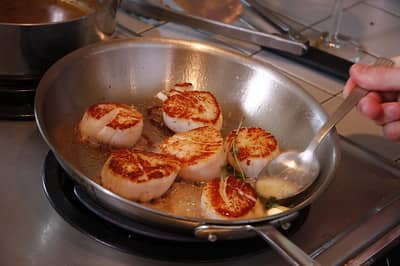
When searing scallops to perfection, choosing the right oil is crucial. A beautifully seared scallop boasts a golden-brown crust that adds a delightful crunch to its tender, succulent flesh. Ideally, the oil you use should have a high smoke point to withstand the intense heat necessary for achieving that desirable sear without burning the scallops. While personal preferences vary, we recommend certain oils that are well-suited for searing scallops. In this article, we’ll explore some top contenders and discuss their unique qualities to help you decide.
But First, What Are Scallops?
Scallops are a type of bivalve mollusk widely known for their delicate and sweet flavor. They are found in oceans worldwide and are highly prized as a culinary delicacy. Scallops have a unique shell shape, which consists of two hinged halves that open and close. The edible part is the adductor muscle, which is the muscle responsible for closing the shell. This meat is what we commonly refer to as a scallop and is the main ingredient used for cooking.
What Do You Need to Make the Best Scallops?
Here’s a list of the key ingredients and kitchen tools you need to cook scallops:
Fresh Scallops: Look for high-quality, fresh scallops from a reputable fishmonger or seafood market. Fresh scallops should have a mild, briny scent and a firm texture. You can also order from online stores you can trust.
Dry-pack scallops are preferred rather than wet-pack scallops. Wet-pack scallops are treated with a solution to preserve their moisture, but this also means the excess liquid is released during cooking, making it impossible to get a good sear. Dry-pack scallops, on the other hand, are not treated and have a more natural flavor and texture, making them ideal for searing.
Oil with a High Smoke Point: Choose an oil that can withstand high heat without burning. Good options include grapeseed oil, canola oil, and clarified butter, AKA ghee.
Seasonings: Keep it simple and enhance the natural flavors of scallops with a simple mix of salt and pepper. You can also add other seasonings like garlic powder or chile flakes if you like a bit of spice.
Cast Iron Skillet or Stainless Steel Pan: These are your best options to achieve a nice sear. These pans distribute heat evenly, allowing for consistent browning. It’s important to preheat the pan properly before adding the scallops to ensure even cooking. Preheating prevents the scallops from sticking to the surface. Just don’t overdo it because it is highly possible to overcook scallops.
Tongs or a Fish Spatula: You’ll need a tool to flip the scallops while cooking. Tongs or a fish spatula are perfect for delicately handling scallops without breaking them.
How Long Do You Cook Scallops?
Proper timing is crucial when cooking scallops to avoid overcooking them, as they can become tough and rubbery if cooked for too long. The cooking time depends on the size of the scallops. As a general guideline, small to medium-sized scallops must cook for about 1-2 minutes per side, while bigger scallops may require 2-3 minutes per side.
Remember to pay close attention to the scallops’ appearance and texture. Once they turn opaque and feel firm to the touch, they are ready to be removed from the heat.
What to Serve with Pan-Seared Scallops
Pan-seared scallops are incredibly versatile and pair well with various side dishes. Here are some delicious options:
Lemon Butter Asparagus: Sauté fresh asparagus in a lemon butter sauce for a vibrant and refreshing side dish that complements the scallops perfectly.
Creamy Risotto: A creamy and cheesy risotto provides a rich and comforting base for the scallops. Choose a classic Parmesan risotto or experiment with different flavors like lemon and thyme.
Roasted Garlic Mashed Potatoes: Smooth and creamy mashed potatoes infused with roasted garlic add a comforting element to the dish and pair wonderfully with the scallops.
Quinoa Salad: A light and refreshing quinoa salad with fresh vegetables, herbs, and a zesty vinaigrette add a healthy and vibrant touch to the meal.
Seared Scallops FAQs
Q: Can I use a non-stick pan for searing scallops?
A: While non-stick pans can be convenient for certain dishes, they are not ideal for achieving a good sear on scallops. Non-stick pans often are limited when it comes to heat retention and browning capabilities, which makes them inferior to cast iron or stainless steel pans.
Q: How do I prevent scallops from sticking to the pan?
A: To prevent scallops from sticking, ensure that your pan is preheated properly, and add the scallops only when the pan is hot. You should also never overcrowd the pan, as this can cause moisture to accumulate and prevent proper browning.
Final Words
Pan-seared scallops are a delightful culinary treat when cooked to perfection. By following the techniques we provided and using the recommended tools and ingredients, you can create a dish that demonstrates the natural sweetness and tender texture of scallops.
Remember to choose high-quality scallops, sear them in oil with a high smoke point, and pay close attention to the cooking time to ensure they are cooked just right. With well-paired side dishes, your pan-seared scallops will be a dish that will impress all your guests. So get cooking and enjoy the culinary journey of preparing and savoring this delectable seafood delicacy!

